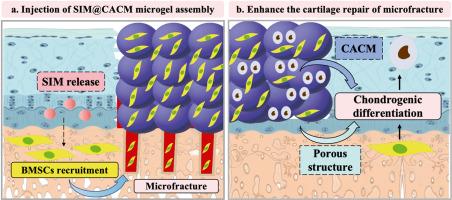具有干细胞招募和软骨分化功能的可注射细胞外基质微凝胶组件可促进基于微骨折的关节软骨再生
IF 18
1区 医学
Q1 ENGINEERING, BIOMEDICAL
引用次数: 0
摘要
尽管经过多年的研究,关节软骨修复和再生仍是一项重大挑战。虽然微骨折技术在临床实践中得到了普遍应用,但新生软骨通常是纤维软骨而非透明软骨,这主要归因于微环境不足,无法有效招募、固定和诱导骨髓间充质干细胞(BMSCs)分化为透明软骨。本文介绍了一种新型软骨无细胞基质(CACM)微凝胶组件,它具有良好的微孔性、注射性、组织粘附性、骨髓间充质干细胞招募和软骨分化能力,可改善基于微骨折的关节软骨再生。具体来说,SIM@CACM 微凝胶组件可持续释放辛伐他汀(SIM),在软骨再生的早期阶段有效招募 BMSCs,而丰富的互联微孔和高比面积可确保 BMSCs 快速粘附、增殖和浸润。此外,CACM 基质中的活性因子、微凝胶组装的适当机械性能以及出色的组织粘附性为 BMSCs 持续分化为透明软骨提供了传导环境。由于上述因素的协同作用,实现了良好的关节软骨修复和再生。本文章由计算机程序翻译,如有差异,请以英文原文为准。

Injectable acellular matrix microgel assembly with stem cell recruitment and chondrogenic differentiation functions promotes microfracture-based articular cartilage regeneration
Articular cartilage repair and regeneration is still a significant challenge despite years of research. Although microfracture techniques are commonly used in clinical practice, the newborn cartilage is usually fibrocartilage rather than hyaline cartilage, which is mainly attributed to the inadequate microenvironment for effectively recruiting, anchoring, and inducing bone marrow mesenchymal stem cells (BMSCs) to differentiate into hyaline cartilage. This paper introduces a novel cartilage acellular matrix (CACM) microgel assembly with excellent microporosity, injectability, tissue adhesion, BMSCs recruitment and chondrogenic differentiation capabilities to improve the microfracture-based articular cartilage regeneration. Specifically, the sustained release of simvastatin (SIM) from the SIM@CACM microgel assembly efficiently recruits BMSCs in the early stage of cartilage regeneration, while the abundant interconnected micropores and high specific area assure the quick adhesion, proliferation and infiltration of BMSCs. Additionally, the active factors within the CACM matrix, appropriate mechanical properties of the microgel assembly, and excellent tissue adhesion provide a conductive environment for the continuous chondrogenic differentiation of BMSCs into hyaline cartilage. Owing to the synergistic effect of the above-mentioned factors, good articular cartilage repair and regeneration is achieved.
求助全文
通过发布文献求助,成功后即可免费获取论文全文。
去求助
来源期刊

Bioactive Materials
Biochemistry, Genetics and Molecular Biology-Biotechnology
CiteScore
28.00
自引率
6.30%
发文量
436
审稿时长
20 days
期刊介绍:
Bioactive Materials is a peer-reviewed research publication that focuses on advancements in bioactive materials. The journal accepts research papers, reviews, and rapid communications in the field of next-generation biomaterials that interact with cells, tissues, and organs in various living organisms.
The primary goal of Bioactive Materials is to promote the science and engineering of biomaterials that exhibit adaptiveness to the biological environment. These materials are specifically designed to stimulate or direct appropriate cell and tissue responses or regulate interactions with microorganisms.
The journal covers a wide range of bioactive materials, including those that are engineered or designed in terms of their physical form (e.g. particulate, fiber), topology (e.g. porosity, surface roughness), or dimensions (ranging from macro to nano-scales). Contributions are sought from the following categories of bioactive materials:
Bioactive metals and alloys
Bioactive inorganics: ceramics, glasses, and carbon-based materials
Bioactive polymers and gels
Bioactive materials derived from natural sources
Bioactive composites
These materials find applications in human and veterinary medicine, such as implants, tissue engineering scaffolds, cell/drug/gene carriers, as well as imaging and sensing devices.
 求助内容:
求助内容: 应助结果提醒方式:
应助结果提醒方式:


